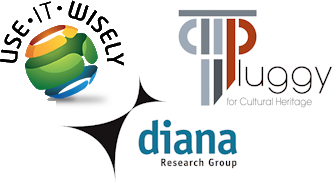
Acknowledgement
This work was partially supported by the Use-it-wisely project and by the PLUGGY project.
Acknowledgement
HOM3R has been developed within the framework of Daniel González Toledo's doctoral thesis, within the DIANA research group of the Department of Electronic Technology of the University of Malaga, as a result of the participation in two research projects funded by the European Union: Use-it-Wisely, by the European Community’s Seventh Framework Programme under grant agreement No. 609027b and PLUGGY by the European Union’s Horizon 2020 research and innovation programme under grant agreement No. 726765.
The Use-It-Wisely project, focusing on improving decision-making processes in turbine inspection and maintenance for energy production, provided the initial impetus for our exploration into 3D collaborative web tools. Through this project, we identified the need for natural interaction techniques, leading to the development of the Hierarchical prOduct Model 3d vieweR (HOM3R). Subsequently, our participation in the PLUGGY project expanded our scope to include cultural heritage, enriching our research and facilitating the refinement and validation of our techniques across different platforms, including mobile devices.
Use it Wisely
Use-it-wisely is a European Union research project, funded under the FP7 framework, which runs from 2013 to 2016. The project draws on the world class knowledge of twenty partners from all over Europe, who are all leaders in their respective fields including: energy, machinery, space, office workspace, vehicles, ship building, furniture, academia, research, dissemination and exploitation.
The project is focused on the end-user. It will enable European manufacturers to produce products and services capable of adapting to rapidly changing markets, the changing business environment, and customer goals by demonstrating the state of the art business model and platform, which enables life-long adaptation of high investment product-service. The adaptation is accomplished by a purposeful and demand-led sequence of innovative continuous product-service upgrades. The project will go through vital steps to ensure a successful outcome. These include: platform development, the design of prototypes, testing of prototypes, demonstration and execution, and key communications and exploitation tasks. See more info.
In particular, hom3r has been integrated as one of the main modules of the collaborative tool implemented by the electric power industry case. This industrial case is composed of three project partners,Tecnatom S.A (a Spanish company that works in inspection and maintenance of power plant machinery), the University of Malaga and the University of Nottingham.
As a collaborative tool, this UiW application consists in a set of interactive views generated from three different data models, see figure 1. The product model contains the geometrical and hierarchical representation of the product (the steam turbine). The service model contains the results of the service (turbine inspection) linked to different areas of the product geometry (the turbine inspection consists in a set of inspections done to different inspection areas). The analysis model consists in a set of collaborative discussions, one for each inspection result.
PLUGGY
PLUGGY seeks to address the need for society to be actively involved in cultural heritage activities, not only as an observer, but also as a maintainer, creator and one of the main influencing factors.
A heritage that is everywhere and relevant to everyday life is one of the preconditions for true sustainability. At present, there are no adequate ICT tools to help citizens in their daily activities to shape cultural heritage and to let themselves be shaped by it. Existing applications and repositories for heritage dissemination do not really create heritage communities. Social platforms certainly offer potential for networking, but they have not yet been exploited in terms of promoting cultural heritage and integrating it into people's daily lives.
PLUGGY, the Pluggable Social Platform for Heritage Awareness and Participation, aims to fill this gap by providing the necessary tools for users to share their local knowledge and everyday experience with others, together with the contribution of cultural institutions, building broad networks around a common area of interest, connecting the past, the present and the future.
Participation in the PLUGGY research project gave us access to a diversity of use cases with 3D objects in a different sector, that of cultural heritage. This allowed us to evaluate and develop our ideas. The PLUGGY project also implied the need for our techniques to be able to operate in a multi-platform environment, including mobile devices, which led to a final refinement and validation of our techniques.
Academic Results
The results were described in the following works:
-
Journals
- Gonzalez-Toledo, D., Cuevas-Rodríguez, M., Garre-Del-Olmo, C., Molina-Tanco, L., & Reyes-Lecuona, A. (2018). HOM3R: A 3D Viewer for Complex Hierarchical Product Models. Journal of Virtual Reality and Broadcasting, 14(3).
- Gonzalez-Toledo, D., Cuevas-Rodriguez, M., Molina-Tanco, L., & Reyes-Lecuona, A. (2022). Still room for improvement in traditional 3D interaction: selecting the fixed axis in the virtual trackball. Visual Computer.
- Gonzalez-Toledo, D., Cuevas-Rodriguez, M., Molina-Tanco, L., & Reyes-Lecuona, A. (2024). The Spheroidal Trackball: generalizing the Fixed Trackball for virtual camera navigation. Visual Computer.
- Book chapters
-
Conferences
- González-toledo, D., Cuevas-rodríguez, M., Garre, C., Molina-tanco, L., & Reyes-lecuona, A. (2015). A Tool for Collaborative Decision Making on Service Information Linked to 3D Geometry of Complex Hierarchical Products. Proceedings of EuroVR2015, 1–6.
- Daniel Gonzalez-Toledo, María Cuevas-Rodríguez, Carlos Garre-Del-Olmo, Luis Molina-Tanco and Arcadio Reyes-Lecuona. HOM3R: A 3D Viewer for Complex Hierarchical Product Models. Proceedings of EuroVR2016, November 2016, Athens. Part of ISBN: 978-618-80348-3-9.
- González-Toledo, D., Cuevas-Rodriguez, M., Molina-Tanco, L., & Reyes-Lecuona, A. (2018). 3D Object Rotation Using Virtual Trackball with Fixed Reference Axis. Proceeding of EuroVR2018, 1, 3–5.
- Reyes-Lecuona, A., Gonzalez-Toledo, D., Cuevas-Rodriguez, M., Herruzo-torrico, M. L., García-puyol, A., & Molina-tanco, L. (2019). PLUGGY3D. Augmented Reality for cultural heritage. Proceedings of the 16th Annual EuroVR Conference - 2019, 103–106.

